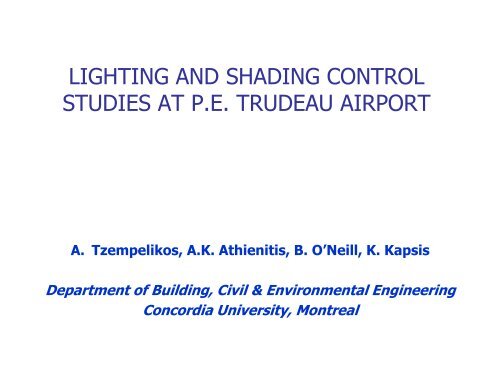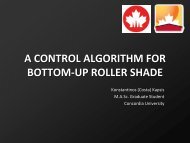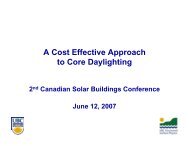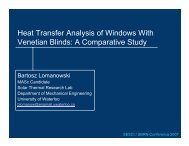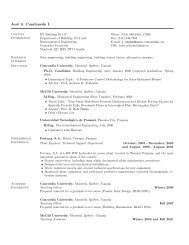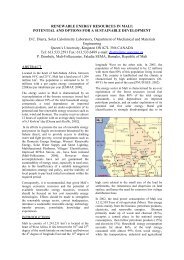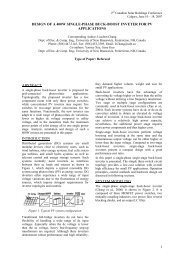lighting and shading control studies at pe trudeau airport
lighting and shading control studies at pe trudeau airport
lighting and shading control studies at pe trudeau airport
- No tags were found...
You also want an ePaper? Increase the reach of your titles
YUMPU automatically turns print PDFs into web optimized ePapers that Google loves.
Motiv<strong>at</strong>ion• The <strong>airport</strong> has several <strong>pe</strong>rimeter zones with very large glazedfacades, which receive significant solar gains throughout the year• They require efficient solar protection, in order to reduce coolingloads <strong>and</strong> dem<strong>and</strong> <strong>and</strong> also prevent glare• These facades were shaded by motorized shades o<strong>pe</strong>r<strong>at</strong>edmanually by the <strong>airport</strong>’s <strong>pe</strong>rsonnel• The building did not have efficient solar protection <strong>and</strong> excessiveenergy was s<strong>pe</strong>nt for cooling
Research & demonstr<strong>at</strong>ion project• A research project started in 2006 between Aeroports de Montreal(ADM), NRCan <strong>and</strong> SBRN• Integr<strong>at</strong>ed approach for <strong>shading</strong>, <strong>lighting</strong> <strong>and</strong> HVAC o<strong>pe</strong>r<strong>at</strong>ion
Methodology flowchart
Phase 1 - Initial studySouth facing zone <strong>and</strong> west corner -53 m long <strong>and</strong> 7m high
D<strong>at</strong>a acquisition <strong>and</strong> <strong>control</strong> system• Sensor d<strong>at</strong>a are read by the Delta <strong>control</strong>ler– Reads light sensor signals– Input signals must be from 0-5 V or 4-20 mA– Monitor <strong>and</strong> <strong>control</strong> shade position– Monitor tem<strong>pe</strong>r<strong>at</strong>ure d<strong>at</strong>a (14000 points)
Light sensors• Four LICOR 210 photometric sensors were used– Small size– Very light– Linear response– 10 s response time– Very accur<strong>at</strong>e (5%)– Cosine corrected
Sensor positioning• Str<strong>at</strong>egic loc<strong>at</strong>ion is important in order to examine the space indetail• De<strong>pe</strong>nd on space geometry, lights loc<strong>at</strong>ion space useBDELECTRIC LIGHTSCBASECONDFLOORCMOTORIZEDSHADESDACONTROLROOMFACADE
Measurements• The sensors’ readings were monitored under various sky conditions<strong>and</strong> shade positions• The objective was to be able to predict interior illuminance based onthe ceiling sensors’ readings; horizontal sensors are visible <strong>and</strong>needed to be removed after the test <strong>pe</strong>riod• Then correl<strong>at</strong>e with horizontal illuminance <strong>and</strong> <strong>control</strong> the shades<strong>and</strong> the lights accordingly• Deciding the number of sensors <strong>and</strong> their loc<strong>at</strong>ion is a keyrequirement of the <strong>control</strong> methodology
13:28:353:44:1619:34:0110:54:161:39:0118:04:227:44:021:14:2313:49:028:24:2419:54:0315:34:241:59:0422:44:258:04:045:54:2614:09:0513:04:2620:14:0620:14:272:19:063:24:288:24:0714:29:0710:34:2820:34:0817:44:292:39:090:54:308:44:098:04:3014:49:1015:14:3120:54:1022:24:322:59:115:34:339:04:1212:44:3315:09:1219:54:3421:14:133:04:353:19:1310:14:359:24:1417:24:3615:29:150:34:3721:34:157:44:373:39:16Illuminance (lux)Illuminance (lx)Measurements <strong>and</strong> correl<strong>at</strong>ions180045001600400014003500120030001000250080020006001500400100020050000Sensor ASensor BSensor ASensor B
Sensor B (ceiling, lux)Correl<strong>at</strong>ions- low illuminances region12001000B = 0.71A - 2780060040020000 200 400 600 800 1000 1200Sensor A (horizontal illuminance, lux)
Sensor B (ceiling, lux)Correl<strong>at</strong>ions- high illuminance region2500B = 0.517A + 9620001500100050001000 1500 2000 2500 3000 3500 4000Sensor A (horizontal illuminance, lux)
Sensor B (ceiling)Final correl<strong>at</strong>ion400035003000B = 0.517×A + 96250020001500B = 0.71×A - 27100050000 500 1000 1500 2000 2500 3000 3500 4000Sensor A (horizontal illuminance)
Set points for <strong>lighting</strong>/<strong>shading</strong> <strong>control</strong>• Minimum required horizontal illuminance: 250 lux (electric lights <strong>at</strong>night)• Lighting <strong>and</strong> <strong>shading</strong> <strong>control</strong> schemes were initially decoupled forsimplicity of o<strong>pe</strong>r<strong>at</strong>ion• For <strong>lighting</strong> <strong>control</strong>, a new illuminance set point was selected forthe daytime (450 lux)• Lights turn off when ceiling sensor reads 300 lux or higher– This includes a 200 lux threshold to account for errors <strong>and</strong>inter-reflections– 15-min time interval to ensure stable conditions (after d<strong>at</strong>acollection <strong>and</strong> averaging)
Set points for <strong>lighting</strong>/<strong>shading</strong> <strong>control</strong>• Shade position is modul<strong>at</strong>ed based on different set points• Shades will close when sunlight is present (ceiling reads 800lux with o<strong>pe</strong>n shades =minimum 540 lux horizontal illuminance) toprevent from overhe<strong>at</strong>ing <strong>and</strong> glare• For this value, lights will remain off; when the measured averagedd<strong>at</strong>a fall below the <strong>lighting</strong> set point, lights will turn on• Shades will o<strong>pe</strong>n when the ceiling reading is less than 500 lux(>200 lux threshold)• Before implementing the <strong>control</strong> schemes in the <strong>airport</strong>, a similarex<strong>pe</strong>rimental setup was installed <strong>and</strong> tested <strong>and</strong> in the Solar <strong>and</strong>Lighting Labor<strong>at</strong>ory of Concordia University
Estim<strong>at</strong>ion of potential energy savings• Day<strong>lighting</strong> simul<strong>at</strong>ions for a full year using the ray-tracing softwareSPOT were <strong>pe</strong>rformed in order to estim<strong>at</strong>e the potential reduction inelectricity consumption for <strong>lighting</strong> due to daylight use• Calcul<strong>at</strong>ion of average annual daylight autonomy (% of workinghours in a year during which n<strong>at</strong>ural light levels are adequ<strong>at</strong>e)• Lighting yearly energy savings:EL PL × ty× A×DA30,000 kWhrs/year (>50%)
Annual cooling energy dem<strong>and</strong> (kWhrs)Estim<strong>at</strong>ion of potential energy savings• Thermal simul<strong>at</strong>ion model (finite difference) to estim<strong>at</strong>e thepotential energy savings (due to reduction in cooling) from <strong>shading</strong>200000<strong>and</strong> <strong>lighting</strong> <strong>control</strong> 182000180000158000160000• Reduction140000in annual cooling energy: >13%120000• Reduction in <strong>pe</strong>ak cooling dem<strong>and</strong>: >20%100000145000800006000040000200000No <strong>control</strong> Shading <strong>control</strong> Shading <strong>and</strong> <strong>lighting</strong> <strong>control</strong>
Phase 2: all <strong>pe</strong>rimeter zones• After successful implement<strong>at</strong>ion, the project moved to the nextphase in spring 2008• 17 large <strong>pe</strong>rimeter zones with different geometrical characteristics<strong>and</strong> orient<strong>at</strong>ions• To avoid using a large number of sensors, only one ceiling sensor(<strong>and</strong> amplifier) was installed in each zone, <strong>and</strong> work planeilluminance was predicted using day<strong>lighting</strong> simul<strong>at</strong>ion models,valid<strong>at</strong>ed with a few manual measurements
Workplane illuminance (lx)Measured vs simul<strong>at</strong>ed correl<strong>at</strong>ion d<strong>at</strong>a4000MeasuredSimul<strong>at</strong>ed3000Linear(Simul<strong>at</strong>ed)2000100000 200 400 600 800 1000 1200 1400 1600 1800 2000Ceiling illuminance (lx)
Fine tuning• Timed <strong>control</strong> was introduced for all west <strong>and</strong> northwest-facingzones, to <strong>control</strong> shades only in the afternoon –in the morning, theyremain o<strong>pe</strong>n for maximizing daylight provision• Seasonal <strong>control</strong> was introduced by adjusting the lower limits ofshade position- based on measured tem<strong>pe</strong>r<strong>at</strong>ure d<strong>at</strong>a, shades willclose no more than 75% when the outdoor tem<strong>pe</strong>r<strong>at</strong>ure is higherthan 5 0 C to harness passive solar gains <strong>and</strong> reduce he<strong>at</strong>ingloads
Fine tuning• The <strong>control</strong> o<strong>pe</strong>r<strong>at</strong>ion was changed from “o<strong>pe</strong>n-close” to a step<strong>control</strong> function which is enabled every 10 minutes. If theshades need to close, they move proportionally (10%)downwards. De<strong>pe</strong>nding on the averaged sensors readings in thenext interval, they will close another 10% if direct sunlight ispresent (higher set point limit) <strong>and</strong> so on• If the reading is between the minimum <strong>and</strong> maximum set point,they will remain in the same position for another 10 min. In thecase when the readings are below the lower set point, the shadeswill o<strong>pe</strong>n by 10% <strong>and</strong>, after 10 min, they will move (or not)according to the next averaged signal
Conclusion• The <strong>control</strong> algorithms were successfully implemented in all <strong>airport</strong>zones in October 2008• The shades close <strong>and</strong> prevent from glare while there is still someview to the outdoors for the travelers• Lights now turn on/off based on the sensors’ readings• The <strong>airport</strong> administr<strong>at</strong>ion will start measuring the energyconsumption in the summer for estim<strong>at</strong>ing the cooling energysavings due to <strong>shading</strong>/<strong>lighting</strong> <strong>control</strong>
Before <strong>and</strong> after
Acknowledgments• This work was funded by Aeroports de Montreal, NRCan(Sustainable Buildings & Communities group) <strong>and</strong> the CanadianSolar Buildings Research Network• The authors would like to es<strong>pe</strong>cially thank Mr. Denis Boilard <strong>at</strong> ADMfor his kind help <strong>and</strong> support


